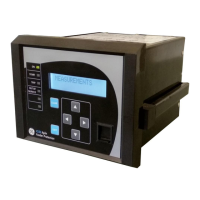However, certain faults may arise which can remain undetected by such schemes. Negative
Sequence Overcurrent elements can be used in such cases.
Any unbalanced fault condition will produce a negative sequence current component. Therefore, a
negative phase sequence overcurrent element can be used for both phase-to-phase and phase-to-
earth faults.
Negative Sequence Overcurrent protection offers the following advantages:
• Negative phase sequence overcurrent elements are more sensitive to resistive phase-to-phase
faults, where phase overcurrent elements may not operate.
• In certain applications, residual current may not be detected by an earth fault element due to the
system configuration. For example, an earth fault element applied on the delta side of a delta-
star transformer is unable to detect earth faults on the star side. However, negative sequence
current will be present on both sides of the transformer for any fault condition, irrespective of the
transformer configuration. Therefore, a negative phase sequence overcurrent element may be
used to provide time-delayed back-up protection for any uncleared asymmetrical faults
downstream.
• Where rotating machines are protected by fuses, loss of a fuse produces a large amount of
negative sequence current. This is a dangerous condition for the machine due to the heating
effect of negative phase sequence current. An upstream negative phase sequence overcurrent
element could therefore be applied to provide back-up protection for dedicated motor protection
relays.
• It may be sufficient to simply trigger an alarm to indicate the presence of negative phase
sequence currents on the system. Operators may then investigate the cause of the imbalance.
2.3.1 Negative Sequence Overcurrent Protection Implementation
Negative Sequence Overcurrent Protection is implemented in the NEG SEQUENCE O/C column of
the relevant settings group.
The product provides three stages of negative sequence overcurrent protection with independent time
delay characteristics.
Stages 1, 2 and 3 provide a choice of operate and reset characteristics, where you can select
between:
• A range of standard IDMT (Inverse Definite Minimum Time) curves
• DT (Definite Time)
This is achieved using the cells
• I2>(n) Function for the overcurrent operate characteristic
• I2>(n) Reset Char for the overcurrent reset characteristic
where (n) is the number of the stage.
The IDMT-capable stages, (1, 2 and 3) also provide a Timer Hold facility. This is configured using the
cells I2>(n) tRESET, where (n) is the number of the stage. Timer Hold facility is applicable for both
IEC and IEEE curves. IEEE & US curves have IDMT reset curve option in addition to DT.
2.3.2 Negative Sequence Overcurrent Protection Logic
For Negative Phase Sequence Overcurrent Protection, the energising quantity I2> is compared with
the threshold current I2>(n) Current Set. If the value exceeds this setting a Start signal (Strt I2>(n)) is
generated, provided there are no blocks. 5% hysteresis is built into the comparator such that the drop-
off value is 0.95 x of the current set threshold.

